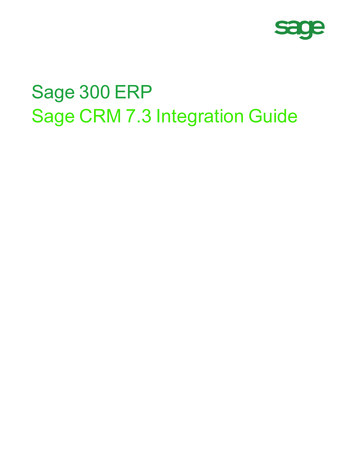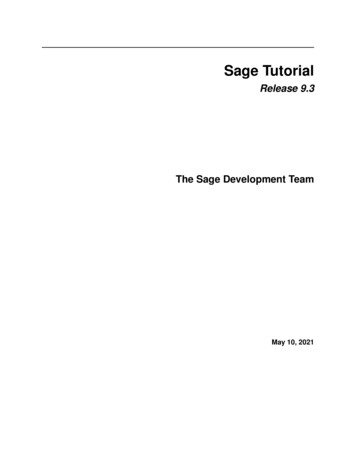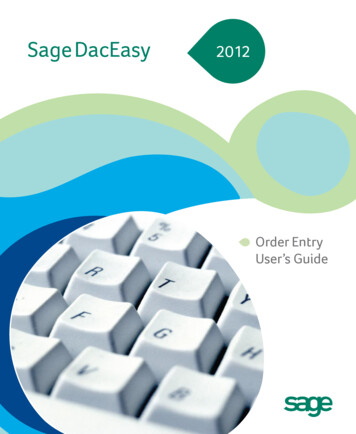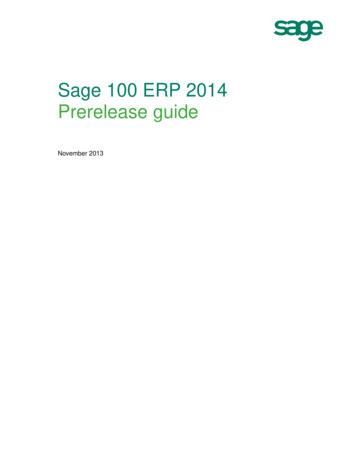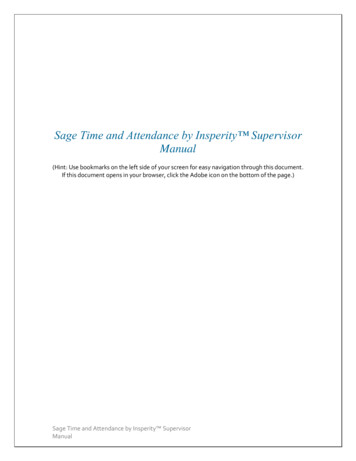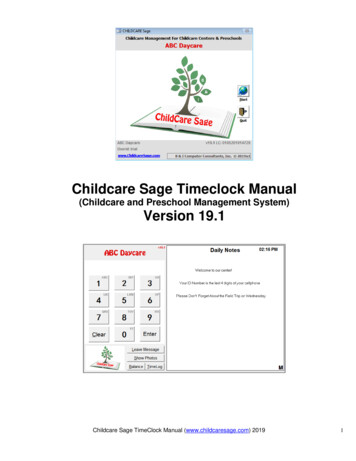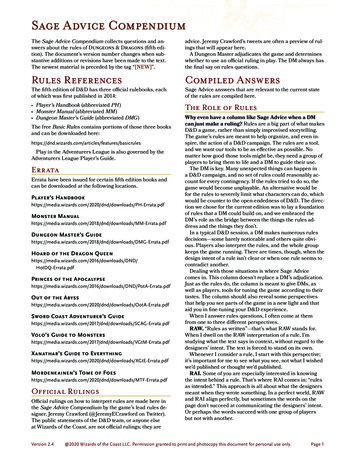
Transcription
Sage Advice CompendiumThe Sage Advice Compendium collects questions and answers about the rules of Dungeons & Dragons (fifth edition). The document’s version number changes when substantive additions or revisions have been made to the text.The newest material is preceded by the tag “[NEW]”.advice. Jeremy Crawford’s tweets are often a preview of rulings that will appear here.A Dungeon Master adjudicates the game and determineswhether to use an official ruling in play. The DM always hasthe final say on rules questions.Rules ReferencesCompiled Answers Player’s Handbook (abbreviated PH) Monster Manual (abbreviated MM) Dungeon Master’s Guide (abbreviated DMG)The Role of RulesThe fifth edition of D&D has three official rulebooks, eachof which was first published in 2014:The free Basic Rules contains portions of those three booksand can be downloaded icrulesPlay in the Adventurers League is also governed by theAdventurers League Player’s Guide.ErrataErrata have been issued for certain fifth edition books andcan be downloaded at the following locations.Player’s ds/PH-Errata.pdfMonster /MM-Errata.pdfDungeon Master’s DMG-Errata.pdfHoard of the Dragon HotDQ-Errata.pdfPrinces of the /DND/PotA-Errata.pdfOut of the OotA-Errata.pdfSword Coast Adventurer’s SCAG-Errata.pdfVolo’s Guide to ds/VGtM-Errata.pdfXanathar’s Guide to oads/XGtE-Errata.pdfMordenkainen’s Tome of TF-Errata.pdfOfficial RulingsOfficial rulings on how to interpret rules are made here inthe Sage Advice Compendium by the game’s lead rules designer, Jeremy Crawford (@JeremyECrawford on Twitter).The public statements of the D&D team, or anyone elseat Wizards of the Coast, are not official rulings; they areVersion 2.4Sage Advice answers that are relevant to the current stateof the rules are compiled here.Why even have a column like Sage Advice when a DMcan just make a ruling? Rules are a big part of what makesD&D a game, rather than simply improvised storytelling.The game’s rules are meant to help organize, and even inspire, the action of a D&D campaign. The rules are a tool,and we want our tools to be as effective as possible. Nomatter how good those tools might be, they need a group ofplayers to bring them to life and a DM to guide their use.The DM is key. Many unexpected things can happen ina D&D campaign, and no set of rules could reasonably account for every contingency. If the rules tried to do so, thegame would become unplayable. An alternative would befor the rules to severely limit what characters can do, whichwould be counter to the open-endedness of D&D. The direction we chose for the current edition was to lay a foundationof rules that a DM could build on, and we embraced theDM’s role as the bridge between the things the rules address and the things they don’t.In a typical D&D session, a DM makes numerous rulesdecisions—some barely noticeable and others quite obvious. Players also interpret the rules, and the whole groupkeeps the game running. There are times, though, when thedesign intent of a rule isn’t clear or when one rule seems tocontradict another.Dealing with those situations is where Sage Advicecomes in. This column doesn’t replace a DM’s adjudication.Just as the rules do, the column is meant to give DMs, aswell as players, tools for tuning the game according to theirtastes. The column should also reveal some perspectivesthat help you see parts of the game in a new light and thataid you in fine-tuning your D&D experience.When I answer rules questions, I often come at themfrom one to three different perspectives.RAW. “Rules as written”—that’s what RAW stands for.When I dwell on the RAW interpretation of a rule, I’mstudying what the text says in context, without regard to thedesigners’ intent. The text is forced to stand on its own.Whenever I consider a rule, I start with this perspective;it’s important for me to see what you see, not what I wishedwe’d published or thought we’d published.RAI. Some of you are especially interested in knowingthe intent behind a rule. That’s where RAI comes in: “rulesas intended.” This approach is all about what the designersmeant when they wrote something. In a perfect world, RAWand RAI align perfectly, but sometimes the words on thepage don’t succeed at communicating the designers’ intent.Or perhaps the words succeed with one group of playersbut not with another.@2020 Wizards of the Coast LLC. Permission granted to print and photocopy this document for personal use only.Page 1
When I write about the RAI interpretation of a rule, I’llbe pulling back the curtain and letting you know what theD&D team meant when we wrote a certain rule.RAF. Regardless of what’s on the page or what the designers intended, D&D is meant to be fun, and the DM isthe ringmaster at each game table. The best DMs shape thegame on the fly to bring the most delight to their players.Such DMs aim for RAF, “rules as fun.”We expect DMs to depart from the rules when runninga particular campaign or when seeking the greatest happiness for a certain group of players. Sometimes my rulesanswers will include advice on achieving the RAF interpretation of a rule for your group.I recommend a healthy mix of RAW, RAI, and RAF!Character CreationHow do you calculate a creature’s Armor Class (AC)?Chapter 1 of the Player’s Handbook (p. 14) describes howto determine AC, yet AC calculations generate questionsfrequently. That fact isn’t too surprising, given the numberof ways the game gives you to change your AC!Here are some ways to calculate your base AC:Unarmored: 10 your Dexterity modifier.Armored: Use the AC entry for the armor you’re wearing(see PH, 145). For example, in leather armor, you calculate your AC as 11 your Dexterity modifier, and in chainmail, your AC is simply 16.Unarmored Defense (Barbarian): 10 your Dexteritymodifier your Constitution modifier.Unarmored Defense (Monk): 10 your Dexterity modifier your Wisdom modifier.Draconic Resilience (Sorcerer): 13 your Dexterity modifier.Natural Armor: 10 your Dexterity modifier your naturalarmor bonus. This is a calculation method typically usedonly by monsters and NPCs, although it is also relevantto a druid or another character who assumes a form thathas natural armor.These methods—along with any others that give you a formula for calculating your AC—are mutually exclusive; youcan benefit from only one at a time. If you have access tomore than one, you pick which one to use. For example, ifyou’re a sorcerer/monk, you can use either Unarmored Defense or Draconic Resilience, not both. Similarly, a druid/barbarian who transforms into a beast form that has natural armor can use either the beast’s natural armor or Unarmored Defense (you aren’t considered to be wearing armorwhen you use natural armor).What about a shield? A shield increases your AC by 2while you use it. For example, if you’re unarmored and usea shield, your AC is 12 your Dexterity modifier. Keep inmind that some AC calculations, such as a monk’s Unarmored Defense, prohibit the use of a shield.Once you have your base AC, it can be temporarily modified by situational bonuses and penalties. For instance,having half cover gives you a 2 bonus to your AC, andthree-quarters cover gives a 5 bonus. Spells sometimesmodify AC as well. Shield of faith, for example, grants a target a 2 bonus to AC until the spell ends.Magic items can also enhance your AC. Here are a fewexamples: 1 chain mail gives you an AC of 17, a ring ofprotection gives you a 1 bonus to AC no matter what you’reVersion 2.4wearing, and bracers of defense grant you a 2 bonus to ACif you’re not wearing armor or using a shield.Racial TraitsDoes the Trance trait allow an elf to finish a long rest in4 hours? If an elf meditates during a long rest (as describedin the Trance trait), the elf finishes the rest after only 4hours. A meditating elf otherwise follows all the rules for along rest; only the duration is changed.Do the lightfoot halfling and wood elf hiding racial traitsallow them to hide while observed? The lightfoot halflingand wood elf traits—Naturally Stealthy and Mask of theWild—do allow members of those subraces to try to hidein their special circumstances even when observers arenearby. Normally, you can’t hide from someone if you’rein full view. A lightfoot halfling, though, can try to vanishbehind a creature that is at least one size larger, and awood elf can try to hide simply by being in heavy rain, mist,falling snow, foliage, or similar natural phenomena. It’s as ifnature itself cloaks a wood elf from prying eyes—even eyesstaring right at the elf! Both subraces are capable of hidingin situations when most other creatures can’t, but neithersubrace’s hiding attempt is assured of success; a Dexterity(Stealth) check is required as normal, and an observant foemight later spot a hidden halfling or elf: “I see you behindthat guard, you tricksy halfling!”Can a dragonborn sorcerer with a draconic bloodlinehave two different kinds of Draconic Ancestry? A dragonborn sorcerer can choose a different ancestor for the racialtrait and for the Dragon Ancestor feature. Your choice forthe racial trait is your actual ancestor, while the choice forthe class feature could be your ancestor figuratively—thetype of dragon that bestowed magic upon you or your familyor the kind of draconic artifact or location that filled youwith magical energy.Class FeaturesWhen you use Extra Attack, do you have to use the sameweapon for all the attacks? Extra Attack imposes no limitation on what you use for the attacks. You can use regularweapons, improvised weapons, unarmed strikes, or a combination of these options for the attacks.BarbarianDoes the barbarian’s Danger Sense work against breathweapons and enemies’ special abilities? A barbarian’sDanger Sense benefits the Dexterity saving throw againstany effect that the barbarian can see.For the barbarian’s Reckless Attack, do you grant advantage to all enemies, or only to the target of your attack?If you use the barbarian’s Reckless Attack, all attack rollshave advantage against you until the start of your next turn.BardDo the benefits from Bardic Inspiration and the guidance spell stack? Can they be applied to the same roll?Yes, different effects stack if they don’t have the same name.If a creature makes an ability check while it is under theeffect of a guidance spell and also has a Bardic Inspirationdie, it can roll both a d4 and a d6 if it so chooses.@2020 Wizards of the Coast LLC. Permission granted to print and photocopy this document for personal use only.Page 2
Is the intent that a bard gets to know the number rolledon an attack roll or ability check before using CuttingWords, or should they always guess? If used on a damageroll, does Cutting Words apply to any kind of damage rollincluding an auto-hit spell like magic missile? You canwait to use Cutting Words after the roll, but you must commit to doing so before you know for sure whether the totalof the roll or check is a success or a failure. You can useCutting Words to reduce the damage from any effect thatcalls for a damage roll (including magic missile) even if thedamage roll is not preceded by an attack roll.Can a bard replace spells gained through Magical Secrets? When you gain a level in the bard class, the class’sSpellcasting feature lets you replace one bard spell youknow with another bard spell of an appropriate level. Aspell learned through your Magical Secrets feature countsas a bard spell for you, so it can be replaced upon gaining abard level later. But it must be replaced by a bard spell, according to the rule in the Spellcasting feature.Which spell scrolls can bards understand—spells fromthe bard list only, or spells from the bard list plus spellsfrom Magical Secrets? A bard can use any spell scroll thathas a bard spell on it—including spells gained from theMagical Secrets feature, which are treated as bard spellsfor that character.ClericWhen a cleric uses the Destructive Wrath feature, doesit maximize all damage getting rolled, as long as some ofit is lightning or thunder? Destructive Wrath is meant tomaximize lightning and thunder damage only.DruidWhat happens if a druid wears metal armor? Thedruid explodes.Well, not actually. Druids have a taboo against wearingmetal armor and wielding a metal shield. The taboo hasbeen part of the class’s story since the class first appearedin Eldritch Wizardry (1976) and the original Player’s Handbook (1978). The idea is that druids prefer to be protectedby animal skins, wood, and other natural materials thataren’t the worked metal that is associated with civilization.Druids don’t lack the ability to wear metal armor. Theychoose not to wear it. This choice is part of their identityas a mystical order. Think of it in these terms: a vegetariancan eat meat, but chooses not to.A druid typically wears leather, studded leather, or hidearmor, and if a druid comes across scale mail made of amaterial other than metal, the druid might wear it. If youfeel strongly about your druid breaking the taboo and donning metal, talk to your DM. Each class has story elementsmixed with its game features; the two types of design gohand in hand in D&D, and the story parts are stronger insome classes than in others. Druids and paladins have anespecially strong dose of story in their design. If you want todepart from your class’s story, your DM has the final say onhow far you can go and still be considered a member of theclass. As long as you abide by your character’s proficiencies,you’re not going to break anything in the game system, butyou might undermine the story and the world being createdin your campaign.Version 2.4Can a bound and gagged druid simply use Wild Shape toget out? It’s hard to capture someone who can turn intoa mouse at will. Transforming into a different size can bean effective way of escaping, depending on the nature ofthe bonds or confinement. All things considered, someonetrying to keep a druid captive might be wise to stash theprisoner in a room with an opening only large enough forair to enter.Does the druid’s Elemental Wild Shape limit you to thefour creatures listed, or can you turn into any creaturewith the elemental type? The creatures listed in ElementalWild Shape—air, earth, fire, and water elementals—are specific creatures in the Monster Manual, not creature types orsubtypes. Elemental Wild Shape allows you to transforminto one of those creatures.Can a Circle of the Moon druid speak the languages itknows while in the form of an elemental? Yes, since theelementals listed in Elemental Wild Shape can speak.A literal interpretation (RAW) of Wild Shape couldreasonably lead you to think that transformed druidscan speak only languages that appear in an elemental’sstat block, but the intent (RAI) is that druids retain theirknowledge, including of languages, when they transformand can speak the languages they know if an adopted formcan speak.If a druid in elemental form can speak, can the druidcast spells? A druid can cast spells in a Wild Shape formonly upon gaining the Beast Spells feature at 18th level.If a druid takes the Magic Initiate feat and choosesdetect magic as their one spell, can the druid cast thatspell as a ritual? A druid’s Ritual Casting requires a ritualto be prepared. The spell from Magic Initiate is known butnot prepared.FighterDoes the fighter’s Action Surge feature let you take anextra bonus action, in addition to an extra action? ActionSurge gives you an extra action, not an extra bonus action.(Recent printings of the Player’s Handbook no longer include the wording that provoked this question.)Can a fighter have two fighting styles active at once?Dueling and Defense, for example. You can benefit frommore than one Fighting Style option at a time, as long asthey don’t have conflicting requirements, as Dueling andGreat Weapon Fighting do.Does the Archery fighting style work with a meleeweapon that you throw? No, the Archery feature benefitsranged weapons. A melee weapon, such as a dagger orhandaxe, is still a melee weapon when you make a rangedattack with it.Is the Dueling fighting style intended to support a shield?Yes. A character with the Dueling option usually pairs aone-handed weapon with a shield, a spellcasting focus, or afree hand.If you use Great Weapon Fighting with a feature like Divine Smite or a spell like hex, do you get to reroll any 1 or2 you roll for the extra damage? The Great Weapon Fighting feature—which is shared by fighters and paladins—ismeant to benefit only the damage roll of the weapon usedwith the feature. For example, if you use a greatswordwith the feature, you can reroll any 1 or 2 you roll on the@2020 Wizards of the Coast LLC. Permission granted to print and photocopy this document for personal use only.Page 3
weapon’s 2d6. If you’re a paladin and use Divine Smite withthe greatsword, Great Weapon Fighting doesn’t let you reroll a 1 or 2 that you roll for the damage of Divine Smite.If my Battle Master fighter provokes an opportunity attack and it misses, can I use Riposte? Yes, you can use theRiposte maneuver in response to an opportunity attack thatmisses you, assuming your reaction is available.Does the “when” in the Eldritch Knight’s War Magic feature mean the bonus attack comes after you cast the cantrip, or can it come before? The bonus action comes afterthe cantrip, since using your action to cast a cantrip is whatgives you the ability to make the weapon attack as a bonusaction. That said, a DM would break nothing in the systemby allowing an Eldritch Knight to reverse the order of thecantrip and the weapon attack.If my Eldritch Knight casts true strike and has the WarMagic feature, is the attack granted by War Magic madewith advantage because of true strike? No. The attackfrom War Magic is made normally, and you get the benefitof true strike on your next turn if the spell hasn’t ended.MonkIf a monk uses a staff or another versatile weapon twohanded, does it still count as a monk weapon? Yes. Amonk weapon must lack the two-handed property, but nothing prevents a monk from wielding such a weapon with twohands. Fundamentally, a monk weapon counts as such nomatter how a monk uses it.The dart is not classified as a monk weapon, yet a monkgets 10 darts as starting equipment. Why is that? Starting equipment often lends versatility to a character. In thiscase, a monk’s darts provide a ranged attack option, not aMartial Arts option.Does the Martial Arts feature turn monk weapons andunarmed strikes into finesse weapons? No. The featuregrants a benefit that is similar to the finesse property, butthe feature doesn’t confer that property.When a monk using Deflect Missiles catches and throwsa projectile, what is the damage of the attack? A missilecounts as a monk weapon if it is thrown using DeflectMissiles; it deals its damage or Martial Arts damage (themonk’s choice).Can a monk use Stunning Strike with an unarmedstrike, even though unarmed strikes aren’t weapons? Yes. Stunning Strike works with melee weaponattacks, and an unarmed strike is a special type of meleeweapon attack.The game often makes exceptions to general rules, andthis is an important exception: that unarmed strikes countas melee weapon attacks despite not being weapons.When a monk uses Empty Body, does the invisibilityremain in effect after the monk attacks? Yes. The invisibility of the monk’s Empty Body isn’t ended by the monkattacking.Does a monk’s Purity of Body feature grant immunity topoison damage, the poisoned condition, or both? Thatfeature grants immunity to both. As a result, a monk withPurity of Body can, for example, inhale a green dragon’spoison breath unharmed. Similarly, the monk is unaffectedby ray of sickness, which both deals poison damage and imposes the poisoned condition.Version 2.4Can the monk’s Open Hand Technique push a Large orlarger creature or knock it prone? The Open Hand Technique intentionally ignores creature size. A monk’s ki fuelsmany extraordinary effects! If a feature is limited by creature size, the feature tells you so.Does a monk need to spend any ki points to cast the minor illusion cantrip granted by the Shadow Arts feature?No. The ki point cost in the feature applies only to the otherspells in it.For a Way of Shadow monk, can their silence be dispelled? A spell is a spell, no matter its source. When youcast a spell through a feature, the spell is subject to the normal spellcasting rules, unless the feature says otherwise.Can a monk of the Way of the Four Elements replace Elemental Attunement with another elemental discipline?Yes. Even though you know Elemental Attunement automatically, without having to choose it, you can exchange it for adifferent discipline at 6th, 11th, or 17th level.PaladinWould a Paladin’s Divine Sense register a tiefling dueto their infernal heritage? A tiefling is a humanoid, nota fiend, and therefore escapes the notice of Divine Sense.The feature detects creatures that have the celestial, fiend,or undead creature type.Can my paladin use a smite spell along with DivineSmite? As in, I cast wrathful smite, hit, then use DivineSmite on the same attack? Yes, you can use Divine Smiteon the same weapon attack that benefits from a smite spell,such as wrathful smite—as long as the attack you make after casting the smite spell is a melee weapon attack. DivineSmite doesn’t work with any other kind of attack.RangerThere is no component pouch option in the ranger’sstarting equipment. Does the class not need one, nor afocus for spells? Like other spellcasters, the ranger followsthe rule on components in chapter 10 of the Player’s Handbook. A ranger typically uses a component pouch for thematerial components of spells, but doesn’t start with onebecause rangers don’t have spells at 1st level.Can a ranger move between the attack rolls of the Whirlwind Attack feature? No. Whirlwind Attack is unusual, inthat it’s a single attack with multiple attack rolls. In mostother instances, an attack has one attack roll. The rule onmoving between attacks (PH, 190) lets you move betweenweapon attacks, not between the attack rolls of an exceptional feature like Whirlwind Attack.RogueCan a rogue use Sneak Attack more than once perround? The Sneak Attack description specifies that youcan use the feature once per turn, but it’s not limited to yourturn. The feature also doesn’t limit the number of times youcan use it in a round.You sometimes get a chance to use Sneak Attack onsomeone else’s turn. The most common way for this tohappen is when a foe provokes an opportunity attack fromyou. If the requirements for Sneak Attack are met, youropportunity attack can benefit from that feature. Similarly,a fighter could use Commander’s Strike to grant you anattack on the fighter’s turn, and if the attack qualifies, it can@2020 Wizards of the Coast LLC. Permission granted to print and photocopy this document for personal use only.Page 4
use Sneak Attack. Both of those options rely on the use ofyour reaction, so you could do only one of them in a round.Because you get only one reaction per round, you’re unlikely to use Sneak Attack more than twice in a round: oncewith your action and once with your reaction.For Sneak Attack, what if another enemy of your targetwas 10 feet away with a polearm (which has a reach of10 feet), instead of 5 feet away? Would you still be able touse Sneak Attack? The 5-foot limitation in Sneak Attackis unaffected by the reach of a weapon. That other enemyof the target is creating a close-up distraction, regardless ofthe weapon in hand.Does Uncanny Dodge work automatically against everyattack a rogue or ranger gets hit by? Spell attacks too?A use of Uncanny Dodge works against only one attack,since it expends your reaction, and only if you can see theattacker. It works against attacks of all sorts, including spellattacks, but it is no help against a spell or other effect, suchas fireball, that delivers its damage after a saving throwrather than after an attack roll.Can a rogue use Evasion if they are surprised? The rulestates that if you are surprised, you can’t move or take anaction. A surprised rogue can use Evasion, since that feature doesn’t require the rogue to take an action or move.Can the rogue’s Reliable Talent feature be used in conjunction with Remarkable Athlete or Jack of All Trades?No. Each of these features has a precondition for its use;Reliable Talent activates when you make an ability checkthat uses your proficiency bonus, whereas the other two features activate when you make an ability check that doesn’tuse your proficiency bonus. In other words, a check thatqualifies for Reliable Talent doesn’t qualify for RemarkableAthlete or Jack of All Trades. And Remarkable Athlete andJack of All Trades don’t work with each other, since you canadd your proficiency bonus, or any portion thereof, onlyonce to a roll.Can a thief use the Fast Hands feature to activate amagic item? No. One of the benefits of Fast Hands is beingable to take the Use an Object action as a bonus action, butusing a magic item doesn’t fall under Use an Object, as explained in the Dungeon Master’s Guide (p. 141). In contrast,using a nonmagical item, such as a healer’s kit, is in thedomain of Use an Object.For triggering the rogue’s Assassinate ability, when doesa creature stop being surprised? After their turn in theround, or at the end of the round? A surprised creaturestops being surprised at the end of its first turn in combat.SorcererIf a sorcerer casts a spell with only verbal or somaticcomponents using Subtle Spell, can an opponent usecounterspell against it? If a spell that’s altered by SubtleSpell has no material component, then it’s impossible foranyone to perceive the spell being cast. So, since you can’tsee the casting, counterspell is of no use.Metamagic rules state you can’t use multiple Metamagicoptions on a single spell. Can you use one option multiple times? A sorcerer can use one Metamagic option oncein the casting of a spell, not the same option more thanonce. For instance, a sorcerer can’t quadruple the durationof a spell by spending 2 sorcery points on Extended Spell.Version 2.4Elemental Affinity improves one damage roll of a spell,not multiple rolls? So with scorching ray, I don’t add myCharisma modifier to each ray that hits? That’s correct.Elemental Affinity benefits one damage roll per casting ofa spell, even if the spell allows more than one roll. So, forexample, the feature improves one of the rays of a scorchingray spell or one of the beams of an eldritch blast spell.Can Empowered Spell affect all the rays of a scorchingray spell, or just one? A sorcerer’s Empowered Spell couldaffect more than one ray of a scorching ray, abiding by thefeature’s die limit. For instance, if you create three rayswith the spell and you have a 3 Charisma modifier, youcould reroll one of the damage dice for each ray, or two ofthe damage dice for one ray and one of the damage dice foranother one.Does Quickened Spell allow a sorcerer to cast two spellsa round of 1st level or higher? No, the sorcerer must follow the rule for casting a spell as a bonus action and casting another spell on the same turn; the other spell must bea cantrip with a casting time of 1 action.Can my sorcerer use Twinned Spell on a spell duplicatedby the casting of a wish spell? And if so, how many sorcery points does it cost? Yes, you can. It costs the numberof sorcery points appropriate for the level of the spell you’reduplicating.Does a sorcerer’s Wild Magic Surge effect replace theeffect of the spell that triggered it, or do both effectshappen? The spell and the Wild Magic Surge effect bothhappen. As clarified in the errata for the Player’s Handbook,a surge effect that normally requires concentration does notrequire concentration in this case.[NEW] Can my sorcerer use Twinned Spell to affecta particular spell? You can use Twinned Spell on aspell that targets only one creature doesn’t have a range of self is incapable of targeting more than one creature at thespell’s current levelIf you know this rule yet are still unsure whether a particular spell qualifies for Twinned Spell, consult with your DM,who has the final say. If the two of you are curious aboutour design intent, here is the list of things that disqualify aspell for us: The spell has a range of self. The spell can target an object. The spell allows you to choose more than one creatureto be affected by it, particularly at the level you’re castingthe spell. Some spells increase their number of potentialtargets when you cast them at a higher level. The spell can force more than one creature to make asaving throw before the spell’s duration expires. The spell lets you make a roll of any kind that canaffect more than one creature before the spell’s duration expires.WarlockDo warlock spells granted by the Expanded Spell Listfeature count against the number of spells known? Thespells granted by that feature aren’t automatically knownby a warlock. Those spells are added to the warlock spelllist for the character, who can choose them when learning@2020 Wizards of the Coast LLC. Permission granted to print and photocopy this document for personal use only.Page 5
a new warlock spell of the appropriate level. Once learned,such a spell does count against the number of spells thewarlock knows.Does the Eyes of the Rune Keeper invocation work onmagical runes? Eyes of the Rune Keeper lets you readany form of writing, includ
The free Basic Rules contains portions of those three books and can be downloaded here: . and we embraced the DM’s role as the bridge between the things the rules ad- . that help you see parts of the game in a new light and that aid you in fine-tuning your D&D experience


